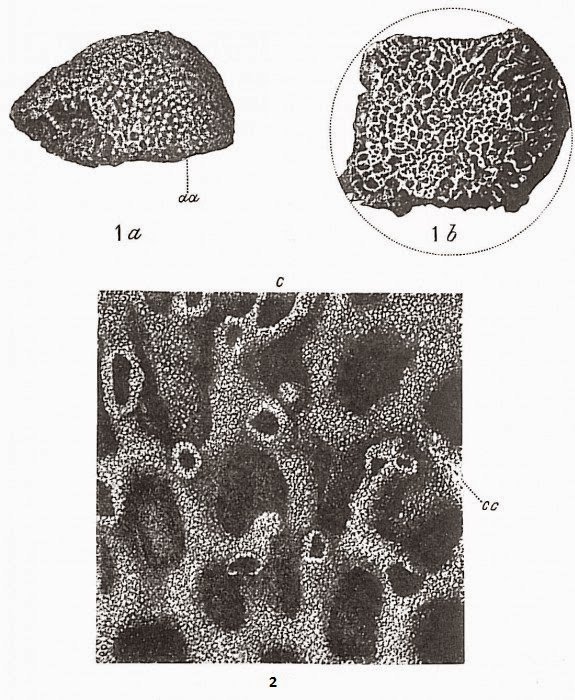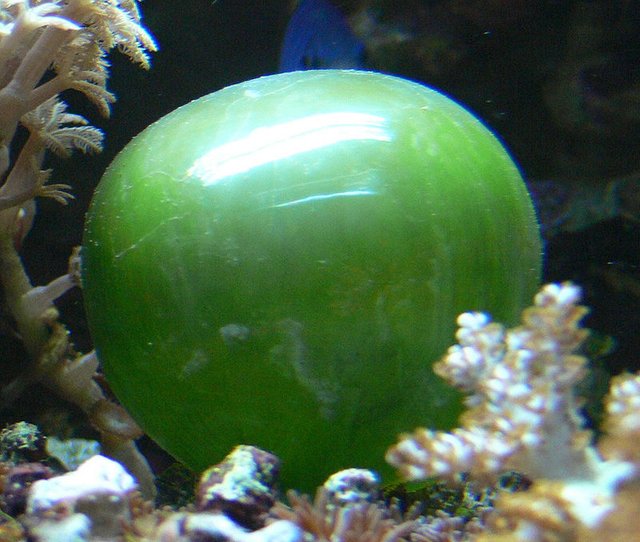Syringammina fragilissima: The World's Largest One-Cell Organism
My guess is that you already know about the existence of simple, one-cell (unicellular) organisms, like bacteria and protozoa. Maybe you can even name a few species! As expected, the majority of these organisms are invisible or barely visible to the naked eye. After all, how big can one cell get, right?
Well, today's post might surprise you. It's about a true giant! A unicellular organism that's so big you won't believe it actually exists!
Meet...
Syringammina fragilissima: The World's Largest One-Cell Organism
Pictured above is Syringammina fragilissima, a sponge-like unicellular organism , that can be found in the sea floors of Europe as well as Africa.
Despite its' looks, it has nothing to do with sponges that belong to the Animalia kingdom. Instead, this poorly understood species is the largest member of Xenophyophores, an also poorly understood group of giant multinucleate unicellular organisms found on all four oceans, at depths ranging from 500 to 10,600 meters.
Out of the few S. fragilissima specimens ever caught, the largest one was 20 centimetres (8 in) across! For comparison, the largest human cell is the ovum, the female sex cell, which is about 1 millimeter in diameter.
Now, let's learn more about these amazing creatures!
Description
Like all other Xenophyophores, the body of S. fragilissima is composed of cytoplasm, containing multiple nuclei surrounded by branches of tubes called granellare. On the outside, the granellare are surrounded by a test, a shell-like structure.
The test, covers the cell branches and all the tubes underneath it. The test is essentially the outer cell and is made up of an network of very fragile and easily broken tubes. This is why scientists have a real hard time obtaining intact specimens. This is also why the organism is called Syringammina fragilissima which translates to, "very fragile sand pipe". [3]
The sketch below was drawn in 1918 (credit: The Foraminifera of the Atlantic Ocean ) and shows the complex network of tubes the test is made of:

What are the "shells" made of?
Research has shown that xenophyophores are a type of foraminiferan – a group of amoebae that has tests (shells) formed from calcium carbonate. Interestingly, xenophyophores do not have calcium carbonate in their tests. Why? It's simple! At the extreme deep-sea pressures they live, the calcium carbonate is soluble in water. In xenophyophores, the tests are made from an organic “glue” mixed with particles from minerals, the skeletal remains of small organisms, clay and other substances they pick from the ocean floor. This is hinted by their greek-derived name, xenophyophores translates to “the bearer of foreign bodies”. [4]
Feeding
Altough we don't know the exact feeding behavior of S. fragilissima, it is believed to be similar to other xenyophores. These organisms root through the muddy sediments of the sea floor and excrete a slimy substance that covers large areas, enveloping food items with a foot-like structure called pseudopodium. This is actually very similar to how amoebas feed.
What exactly S. fragilissima feeds on is a mystery. Research has shown high concentrations of lipids within its cytosol, suggesting a diet based on bacteria. [3]
Discovery
The species was discovered in 1882, when two specimens were collected by the Triton ship in 1882, somewhere in the sea north of Scotland, under the guidance of oceanographer John Murray. When recovered, both specimens were broken in many pieces.
Despite their bad shape, Murray knew he had a previously undiscovered species in his hands and send the specimens to his colleague Henry Brady for further examination. The two later named the species S. fragilissima which as aforementioned translates to "fragile sand pipe".
But Murray and Brady hadn't just discovered a new species. They had discovered the first representative of a whole new group of organisms that we now call xenophyophores.
More than a hundred years later, in 2006, an expedition in an undersea area known as Darwin Mounds, northwest of Scotland, recovered more specimens, with the largest one having a diameter of 20 cm.
Questions waiting to be answered..
Like with all Xenophyophores, there are so many things we don't know yet about Syringammina fragilissima. What do they eat? How do they reproduce? How about their life cycle? Is the species similar to its relatives from the Foraminifera phylum and can switch between sexual and asexual reproduction? Why are their shells rich in tiny crystals of barium sulphate (BaSO4)? Is it a waste product or does it serve some purpose? How long do they live?
Unfortunately, it seems like we won't be getting answers anytime soon. Their deep-sea environment and limited distribution results in a very limited supply of specimens. And even when researchers manage to get their hands on one, it's usually broken in many pieces!
Video
If you enjoyed reading about S. fragilissima then I am sure you will enjoy this video by SciShow:
Extra - World's Second Largest Unicell Organism
credit
You now maybe wondering, "Ok, what's the second largest one-cell organism?". If we take xenyophores out of the equation, then the record goes to Valonia ventricosa, commonly known as the "bubble algae" and "sailors' eyeballs". Their size usually ranges from from 1 to 4 centimetres (0.4 to 1.6 in) in diameter although there are reported cases of individuals with a diameter of up to 5.1 centimetres (2.0 in)!
References
- http://linkinghub.elsevier.com/retrieve/pii/S0967063704001128
- https://microbewiki.kenyon.edu/index.php/Syringammina_fragilissima
- http://archimer.ifremer.fr/doc/00000/10798/
- https://www.decodedscience.org/xenophyophores-reach-new-depths-giant-amoebae-found-in-mariana-trench/6885
SteemSTEM
Please consider supporting the @steemstem project. SteemSTEM is a community driven project which seeks to promote well written/informative Science Technology Engineering and Mathematics postings on Steemit. Click here to join the chat and learn more! The steemstem project is run by @justtryme90, @lemouth and some other cool guys & gals :)
More Strange Animals To Come
I will be posting one new strange animal each and every day so if you enjoyed this post make sure to follow me and let's discover together some of the world's most strange and bizarre creatures! An upvote and resteem would be nice too :P
In the meantime, you may want to check out these 5 Solar-Powered animals, the fungus that turns ants into zombies and the helicopter-like Brazilian Treehopper.


Call me on my cell-spong, late night when i need the big one,
Anyways, i couldve swore the ostrich egg was the biggest, but alas my homeschooling was 2003 so that could be why, thanks for the info of daily science!
Nice
@steemcleaners
Yup.
This is awesome, thanks for sharing! Had no clue this existed O_o
You should do a post on sea cucumbers, they have some pretty interesting variety going on for such a basic organism.
Thanks for the comment. I will. Cucumberes are definitely in the to do list. Stay tuned, new post will come out in about an hour ^_^
Woah.
Resteemed and 100% upvoted. Thank you for using my service!
Read here how the new green bot from Berlin works.
@resteem.bot
Wow this is very interesting! I'm following you :)
Thank you! Stay tuned, I am uploading a weird creature every day :)
Good post. Now I have new information about underwater species. I also have information about the tortoise at @ atafauzan79 please see. thank you
it would be even more awesome if you upvoted before self-advertising!
RISE UP AGAINST THE SPAM
That's one really big cell!
Keep up the good work @trumpman! :)
This post was resteemed by @resteembot!
Good Luck!
Learn more about the @resteembot project in the introduction post.